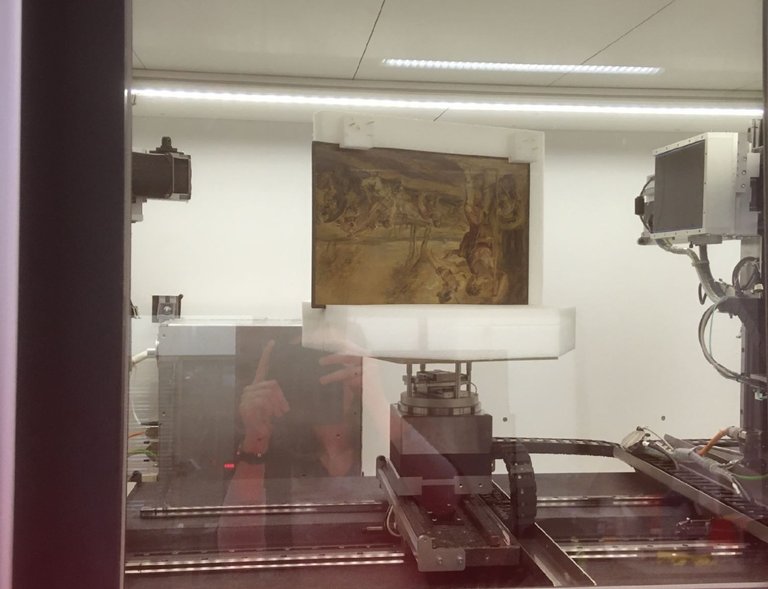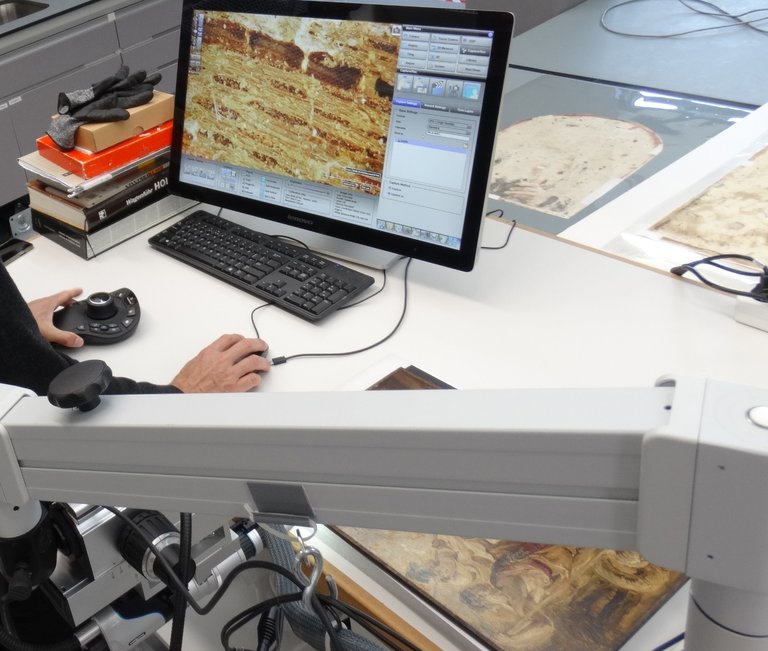CT scans of a Rijksmuseum panel painting in CWI’s FleX-ray laboratory have revealed a surprising insight: it turns out it was not painted on oak, as was always assumed, but on tropical wood. The panel painting "Cadmus, Guided by Minerva, Observes the Spartoi Fighting" is a small oil sketch on panel attributed to an unknown imitator of Peter Paul Rubens (27.7 cm high x 43.3 cm wide).
The CT scans were taken at CWI as part of a larger investigation into the history and origin of the painting. An interdisciplinary group of researchers from the UvA, the Rijksmuseum and CWI worked together to discover as much as possible about the painting. The purpose of the CT scans was to visualize the tree rings in the oak back board. This was important because in order to date the wood based on dendrochronology, a cross section of the plank was needed. This was not available from the outside, due to a thin frame around the painting. Dating the wood can provide crucial information for determining a production date, which in some cases can support or refute an attribution to an artist or a studio.

Painting in the scanner of the FleX-ray Lab at CWI
The painting was taken to CWI's FleX-ray laboratory for CT scanning. The resulting images yielded a surprise. It turned out that the painting itself was not on the oak board, but on a second very thin board that had been glued to it. This is an extraordinary discovery. Dendrochronologist Marta Domínguez-Delmás explains, "The oak board may have been added later for conservation purposes or with misleading intent, namely to pretend that the painting was made on an oak panel, something that would have been more obvious in the 17th century."
In addition to this extraordinary discovery, the CT images also made it possible to date the oak panel, which had been difficult before. Dendrochronologist Dr. Marta Domínguez-Delmás explains: 'Because the panel is covered with oak strips on all sides, the tree rings that are usually visible on the sides of the wood are not accessible. Computed Tomography (CT), a method known from medical science, which can also be used to examine art objects, now offers a solution.' The tree from which the wood came must have been felled after 1557 CE.
Francien Bossema, PhD student at CWI’s Computational Imaging group, worked on the CT images: 'Non-invasive imaging techniques are rarely used for dendrochronological examination of art objects, despite the valuable information they provide,' she explains. In this case, the CT scan was the key to discovering the two different panels and enabled correct dating of the oak panel. Bossema: 'This research shows that implementing non-invasive imaging techniques to study artworks of different shapes and materials can be of great added value and can sometimes lead to unexpected discoveries'.

Inspection of the panel painting
Follow-up research
Because the painting was not painted directly on the oak panel, the established felling date is not indicative of the sketch itself. Domínguez-Delmás: 'Many questions remain open for further research. For example, the oil sketch is described in the Rijksmuseum catalog as painted on paper applied to panel, something Rubens himself did not do as far as we know.' Erma Hermens, researcher at the Rijksmuseum and State Professor of Technical Art History at the UvA explains: 'The new dendrochronological research adds important new data for the interpretation of this oil sketch. It also raises many new questions about the dating and place of production and about the function of the panel. Hopefully, with research into the painting technique and materials, the story of this sketch can be further completed'.
The painting
The panel painting "Cadmus, Guided by Minerva, Observes the Spartoi Fighting" is a small oil sketch on panel. The sketch is described as a copy after an original by Rubens (Private Collection, UK). The representation by Rubens was the model for a larger painting executed by Jacob Jordaens, for the Torre de la Parada, part of an ensemble of over 60 paintings as a commission to Rubens, for the hunting lodge of Philip IV, near Madrid (Spain).
